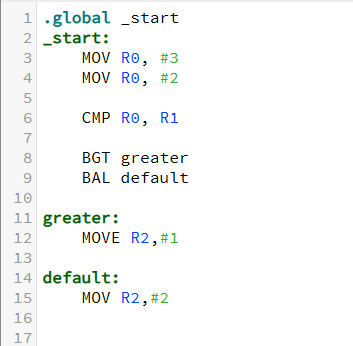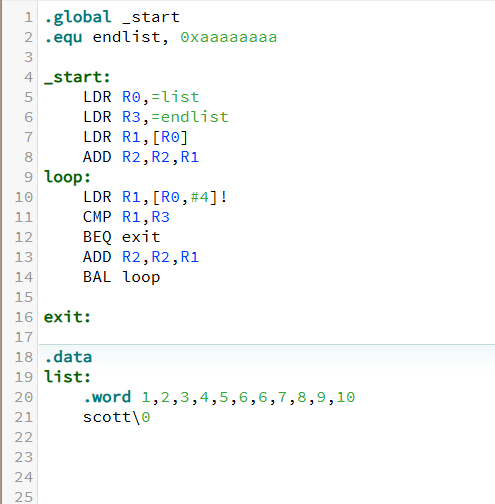Assembly Language Programming(5) Condition, Loop
 박서경
박서경Condition

.global _start
_start:
MOV R0, #3 ; Store 3 in R0
MOV R1, #2 ; Store 2 in R1
CMP R0, R1 ; Compare R0 and R1 (R0 - R1)
BGT greater ; Branch to 'greater' if R0 > R1
BAL default ; Always branch to 'default'
greater:
MOV R2, #1 ; Set R2 to 1 if R0 > R1
default:
MOV R2, #2 ; Set R2 to 2 (default case)
1. MOV R0, #3 & MOV R1, #2
R0 = 3R1 = 2
2. CMP R0, R1 (Compare)
Performs subtraction:
R0 - R13 - 2 = 1 (positive result)Updates CPSR flags but does not store the result.
3. BGT greater (Branch if Greater)
Condition: If R0 > R1, jump to
greater.Since
3 > 2is true, the processor jumps togreater.
4. BAL default (Branch Always)
If the condition was false, this instruction would always jump to
default.However, since
BGTalready jumped togreater,BAL defaultis never executed.
5. greater:
Since
R0 > R1, execution jumps here.MOV R2, #1→ R2 is set to1.
6. default:
This label is ignored in this case, as execution already jumped to
greater.MOV R2, #2is never executed.
Result
R2 = 1(sinceR0 > R1)
✅ CMP & BGT
| Instruction | Meaning | Condition |
| CMP R0, R1 | Compare R0 - R1 | Updates CPSR flags |
| BGT label | Branch if Greater | If R0 > R1 (N=0, Z=0, C=1) |
| BAL label | Branch Always | Jumps unconditionally |
✅ Summary
Compares
R0andR1usingCMP R0, R1.If
R0 > R1, jumps togreater→R2 = 1.If
R0 <= R1, it would jump todefault(not executed in this case).Final result:
R2 = 1since3 > 2. 🚀
Loop

✅ Code Analysis (ARMv7 Assembly)
.global _start
.equ endlist, 0xaaaaaaaa ; Define `endlist` as a constant with the value 0xAAAAAAAA
_start:
LDR R0,=list ; Load the address of `list` into R0
LDR R3,=endlist ; Load the value of `endlist` (0xAAAAAAAA) into R3
LDR R1,[R0] ; Load the first value from `list` into R1
ADD R2,R2,R1 ; Add R1 to R2 (sum initialization)
loop:
LDR R1,[R0,#4]! ; Load the next word from `list` into R1 and increment R0 by 4
CMP R1,R3 ; Compare R1 with `endlist` (0xAAAAAAAA)
BEQ exit ; If R1 == endlist, exit the loop
ADD R2,R2,R1 ; Add R1 to R2 (accumulate sum)
BAL loop ; Always branch back to loop
exit:
.data
list:
.word 1,2,3,4,5,6,6,7,8,9,10 ; Define an array of integers
scott\0 ; Null-terminated string "scott"
✅ Explanation
1. .equ endlist, 0xaaaaaaaa
Defines a constant
endlistwith the value0xAAAAAAAA.This is used as a sentinel value to mark the end of the list.
2. LDR R0,=list & LDR R3,=endlist
LDR R0,=list: Loads the memory address oflistintoR0.LDR R3,=endlist: Loads 0xAAAAAAAA intoR3(used for comparison).
3. LDR R1,[R0] & ADD R2,R2,R1
Loads the first element (
list[0] = 1) into R1.Adds R1 to R2 (initializing sum accumulation).
✅ Loop Execution
4. LDR R1, [R0, #4]!
Loads the next element of
listintoR1.Auto-increments
R0by 4 bytes (moving to the next word in the list).
5. CMP R1, R3
Compares
R1(current value fromlist) withR3(0xAAAAAAAA).If they are equal, it branches to
exit.
6. ADD R2, R2, R1
- Accumulates the sum of all elements.
7. BAL loop
- Unconditionally branches back to
loopto continue summing.
✅ Exit Condition
8. BEQ exit
- If the current value (
R1) matches0xAAAAAAAA, the loop exits.
✅ Data Section (.data)
1. list:
list:
.word 1,2,3,4,5,6,6,7,8,9,10
- This defines an integer array in memory.
2. scott\0
This defines a null-terminated string
"scott", where:s c o t t \0\0(null terminator) marks the end of the string.This is useful for C-style strings.
✅ Execution Summary
Loads and iterates over the
list, summing its values.Stops execution when
0xAAAAAAAAis encountered.Utilizes auto-increment (
LDR R1, [R0, #4]!) to iterate efficiently.
✅ Final Takeaways
Summation Loop: Iterates over the integer list, adding values to
R2.Sentinel Value (
0xAAAAAAAA): Stops execution when encountered.Efficient Memory Access: Uses pre-indexed addressing (
[R0, #4]!).Mixed Data: Contains both integer array and string (
scott\0).Conditional Branching (
CMP,BEQ): Stops execution based on a predefined condition.
This is an efficient method for iterating over a list with a sentinel value. 🚀
Subscribe to my newsletter
Read articles from 박서경 directly inside your inbox. Subscribe to the newsletter, and don't miss out.
Written by
